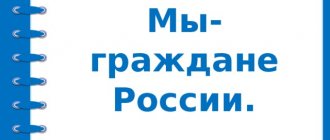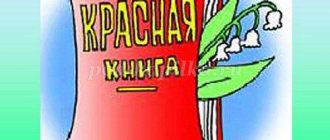Follow the diagram of the main events of this story. Based on the diagram, tell us about them.
The story “Main events about mosquitoes and midges according to the scheme” for 3rd grade
Once upon a time, foolish people on one island decided to get rid of mosquitoes.
They brought pesticides and began poisoning mosquitoes. And the mosquitoes died. But the pesticides got into not only mosquitoes, but also cockroaches, which did not die. However, the poison accumulated in the bodies of the cockroaches. Small lizards ate cockroaches, and cats ate the lizards. And this poison also turned out to be fatal for cats. And soon there were no cats left on the island. There was no one to catch rats and rats developed in huge numbers.
Rats began to eat the grain in the fields and famine began.
check yourself
What is the environment? Describe the environment of the natural objects shown in the diagram.
Everything that surrounds a living being is the environment. In the diagram we see that the hare is surrounded by a forest, which means that for him the forest is an environment. But the hare itself is part of the forest environment.
What does the science of ecology study?
Ecology studies the connections between living things and the environment.
What importance does ecology have for people?
Ecology helps to understand the patterns of development of nature, learn to protect and preserve it, and teaches us to live in harmony with nature.
How can you show ecological connections using a model?
Ecological connections can be indicated by arrows. Moreover, the arrows will be directed in both directions. Because environmental connections are always mutual.
How to help your child become an environmentally literate person
This article will tell you how to help your child become an environmentally literate person.
Ecology is a science
Ecology is a young science that studies and teaches the laws of nature. Ecology is a Greek word that literally translates as “the science of the home.” Home is the world in which people live. The issues of studying this science are important for human life on earth. The section of ecology - valeology studies the quality of life and human health.
The importance of environmental education
Human life is closely connected with nature, which provides health, food, and home. Ecological knowledge will help preserve these gifts and teach you how to properly interact with the environment. Taking good care of the environment will allow you to breathe fresh air, drink clean water, and admire the clear sky.
Environmental Behavior Skills
Environmental behavior is the actions and actions of people that are associated with an impact on the natural environment. People come into contact with environmental issues every minute: the use of water, the need for air, the release of garbage. The quality of life on earth depends on the actions of each person. And in order to become a person capable of positively transforming the world around him, environmental culture must be developed in children from birth.
Methods of environmental education
Visual method: excursions, walks, observations in nature, hikes.
Family hikes have a positive impact on environmental education. In the forest, a child learns to notice the beauty of trees, the sound of the wind, and the singing of birds. Watches the anthill, the butterflies. He learns to treat nature with care and concern when, together with his parents, he removes garbage and puts out fires. Parents explain to the child that the forest is a home for birds, animals, and animals and shows by example how to behave in the forest. If a child realizes from childhood that in the forest he needs to behave like a cultural guest, then he will never cause harm to the world around him.
- While walking, it is useful to observe changes in nature. How do the leaves on trees change in each season? Notice how young grass appears in the spring. See the first yellow leaves on the trees. In winter, look at the snowflakes on the mitten and explain why it doesn’t melt.
- Practical: caring for indoor plants, caring for pets, helping in the garden, at the dacha, in the vegetable garden.
- Parents who allow their child to sow seeds, water the garden bed, pick berries, and water indoor flowers develop responsibility and hard work. Children perform practical tasks with interest.
- Children love pets very much. Walking the dog and playing with the cat keep the child physically active. Let him lead the dog on a leash, change the water in the cat’s bowl, and feed the fish in the aquarium.
- If there is no opportunity or desire to have a pet, then Sunday trips to the zoo or cat and dog exhibition will allow you to observe the life of animals and their habits.
Reading books on ecology for children.
- Reading books on ecology to children teaches them to love and protect nature, introduces them to new animals and natural phenomena. Conversation with the baby has a beneficial effect on the development of speech and mental qualities.
- To ensure that children’s environmental education is carried out with interest, you can photograph nature at different times of the year and create a “Seasons” album. In autumn, collect beautiful leaves and make applique. In summer, play on the sand with sea pebbles and look at shells.
- And most importantly, parents, setting a positive example, will easily raise their child to be an environmentally literate person. In the modern world, a cultured person is aware of a careful attitude towards the world in which he lives.
Homework assignments
Write it in the dictionary: environment, ecology.
Environment - everything that surrounds a living being and with which it interacts
Ecology is the science of the connections between living things and the environment.
Find books on ecology in the library. Read the book you have chosen. Prepare a message on it that complements the lesson material.
Message on a book on ecology for 3rd grade
A message based on the book “Garbage Revolution” by Erica Fyve.
We all know that a person can greatly pollute the environment and cause harm to it. But at the same time, we think only about plants, cars, factories and completely forget about other sources of pollution.
But it turns out that all those items that we use constantly can also become sources of environmental pollution.
How many of us have thought about where candy wrappers, torn T-shirts, old pens and notebooks go?
We throw all these things in the trash and forget about them. But this book tells how exactly different types of garbage are recycled, and how people are trying to make the environment cleaner.
The book raises the important issue of waste recycling, without which it is impossible to maintain a clean environment.
But the book also talks about exactly how certain things are produced. And it often turns out that this process causes harm much greater than the waste itself.
Thus, the book describes how during the production of cotton for jeans, toxic chemicals are released into the environment, poisoning the earth and water.
The book makes you think about how soon humanity will be able to use environmentally friendly production.
Research work “Ecology around us” project on the surrounding world (grade 3)
Content.
| Introduction……………………………………………………………………………………… | With. 2 |
| Chapter I. Environmental ecology is a problem for all mankind…. | With. 4 |
| With. 4 |
| 1.2. The problem of household waste in Russia……………………………… | With. 5 |
| Chapter II. Studying the amount of waste thrown out in the canteen of the Novoselenginsk boarding school and organizing methods for recycling plastic, glass, and metal waste………………………………………………………………………………… | With. 7 |
| Conclusion…………………………………………………………………… | With. 9 |
| Literature…………………………………………………………………… | p.10 |
| Application…………………………………………………………………. | p.11 |
Introduction.
Take care of these lands, these waters,
I love even a small epic.
Take care of all animals within nature,
Kill only the beasts within yourself.
E. Yevtushenko.
Global variability or global change has emerged as a major issue in environmental research in recent years, mainly due to the enormous impact it is likely to have on the global community.
Many natural scientists consider the term “environment” as a synonym for the word “nature”. However, nature becomes the environment only when considered in a social context: human society depends on nature and interacts with it, changing it on different spatiotemporal scales.
Warning about the possible consequences of the expanding human invasion of nature, half a century ago, Academician V.I. Vernadsky wrote: “Man becomes a geological force capable of changing the face of the Earth.” And this warning prophetically came true.
A century and a half ago, a serious revolution took place in the geological sciences: it was proven and recognized that insignificant changes in the natural environment, lasting long enough, lead to radical transformations of the environment, i.e. If we consider changes in the geographical environment on a scale of centuries and millennia, then the results of artificial restructuring of nature (conscious and unintentional) look very impressive. Because human activity, albeit on different, sometimes insignificant scales, over the last 10-20 thousand years has manifested itself on almost the entire landmass (except Antarctica). And everywhere man created around himself centers of change, and even transformation of nature. These outbreaks grew, they became more and more numerous, the restructuring of the environment became radical, and by our century, they have reached truly global proportions.
One day I was walking from school and saw these terrible pictures (see Appendix No. 1). And I became interested: “What can be done so that there is not so much garbage on the streets of our village? What will happen in a few years if all or part of the garbage is not recycled? I believe that we, the children of today, will have to manage the enormous riches of our nature tomorrow. Can’t we now make some, even the slightest, contribution to the future of our planet?
As a result, my research topic emerged: “I don’t want the environment to be disposable (what can I do with trash).”
The purpose of my research: to trace the path of household waste.
Object of study: environment.
Subject of research: household waste.
To achieve this goal, the following tasks were set:
- study the literature on this issue;
- describe the impact of waste on the environment;
- prove that waste recycling is necessary to preserve the environment;
- propose your own methods for recycling household waste.
In my work I used the following methods:
- Theoretical: analysis, generalization.
- Empirical: experiment.
Chapter I. Environmental ecology is a problem for all humanity.
- . The scale of environmental pollution.
With the advent of human civilization, a new factor has emerged that influences the fate of wildlife. It has achieved enormous power in the current century and especially in recent times. The first law on environmental protection is considered to be the edict of the English king Edward (1273), prohibiting the use of coal for heating London dwellings. Violation of the edict was punishable by death.
With the development of science and technology, the quantities and volumes of chemical compounds entering the soil and bowels of the Earth have increased, changing the course of natural cycles. All this has undesirable consequences affecting the economy, social life and health of people.
Man annually extracts over 100 billion tons of minerals from the bowels of the earth, and only 2 percent of raw materials are converted into finished products, and the remaining 98% are waste that pollutes the biosphere. Plants play a huge role in the Earth's biosphere. It is impossible not to mention the harm caused by deforestation. By cutting down forests, we cause the formation of ravines and intense soil loss. But forests are a “factory” of oxygen, they are the “lungs of the planet”, they create a living environment for animals and humans.
Water has always been considered invaluable moisture. In conditions of rapid urban growth and rapid industrial development, the construction of treatment facilities is delayed, as a result of which the water becomes polluted. When pathogens enter a living organism, they find favorable conditions for reproduction, hence the emergence of various epidemics. An important physical factor in the self-purification of reservoirs is ultrasonic radiation from the Sun; under the influence of this radiation, water is disinfected.
The main cause of pollution of water bodies is the discharge of untreated wastewater by industrial enterprises, as well as municipal and agricultural enterprises. Excess chemicals poison the animal and plant world. In addition, chemicals can accumulate in products, posing a significant threat to human health. There is also a very significant source of water pollution that is practically uncontrollable. These are storm and snow runoff from forests and agricultural lands. In terms of pollution, such water flowing from vast territories is comparable to urban sewage water. Wastewater treatment plants play a big role in protecting the environment from pollution. The country takes special care to protect Lake Baikal. This is an amazing creation of nature. In many ways, the “glorious sea” is unique. It is rightly called the factory of crystal clear moisture. Tributaries bring three million tons of soil into the lake annually. Arable and other areas not covered by forest, exposed by logging, are susceptible to erosion. There is a struggle for the safety of the pearl of Siberia. Around the lake, more than 20 million hectares are occupied by forest. They regulate water regime, protect soils from erosion, and keep water clean. As for water transport, any discharge of waste, even treated waste, is prohibited from ships.
1.2. The problem of household waste in Russia.
There is another problem of household waste in Russia.
From the beginning of the 70s to the end of the 80s, household waste in Russia doubled. This is millions of tons. And this happened due to improved packaging culture and the emergence of a large number of disposable packaging. The problem of waste disposal is especially acute in large cities. All over the world it is solved differently. Until 1987, the most popular method was the disposal of city waste in special landfills. The number of such landfills was about fifty with a total area of several hundred hectares of scarce land. It’s good if the land is unsuitable for land use. The piles of garbage at these landfills are not always reliably covered with soil, and unpleasant odors and fires became the norm in such places. Seeing this condition in city landfills, another solution to this problem was adopted - incinerators and solid waste recycling. It was planned to install special filters; the city authorities were going to export the organic waste to agriculture.
Today the situation is this: the amount of garbage has doubled, but the number of landfills has not decreased at all. Researchers claim that unauthorized landfills have acquired an unprecedented scale - even in the center of Moscow. If we talk about increasing the number of waste incineration stations, the environmental costs of such incinerators are well known, and in economic terms they are unprofitable not only because they are expensive, but also because they burn the most valuable raw materials. Of course, our country is rich in natural resources, maybe even too rich, so why save on matches, they should be burned and thrown away. But such thinking is very dangerous at a time when our environment is already heavily polluted by industrial waste.
Recycling provides society everywhere with a way to "cheat" the problem of waste disposal and, therefore, at the expense of recycling costs, to alleviate environmental stress. Recycling metal, paper, glass, plastic and organic waste reduces energy and raw material requirements. For example, obtaining paper from waste paper instead of wood not only saves valuable forests from deforestation, but also reduces energy consumption for the production of 1 ton of paper by three quarters, requires only half the volume of water consumed when using wood raw materials, and recycling one beverage can saves half a can of gasoline. One ton of recycled aluminum saves 4 tons of bauxite, 700 kg of coke and reduces harmful emissions by 35 kg.
Chapter II. Studying the amount of waste thrown out in the canteen of the Novoselenginsk boarding school and organizing methods for recycling plastic, glass, and metal waste
The problem of waste disposal is acute not only in big cities, but also typical for small towns, towns, villages, and hamlets. And our village of Novoselenginsk is no exception. Although there is a sanitary zone in the area, careless residents throw out garbage near their gardens and take it to the river bank. As a result, some streets are simply impossible to walk through because of the unpleasant smell, the unsightly appearance spoils the mood, and going out into nature is contaminated by heaps of garbage, broken glass, and organic waste. Therefore, I decided to do research in the canteen of the Novoselengt boarding school, the purpose of which is to find out how much plastic, glass, and metal containers are thrown away per month. I recalculated the consumption of plastic, glass, and metal containers per month, and this is what happened:
- plastic bottles: 2 l volume – 32 pieces; volume 1.5 l – 58 pieces; volume 1 l – 40 pieces; volume 0.5 l – 15 pieces.
- plastic jars: yogurt – 134 pieces; from sour cream – 82 pieces; others - 41 pieces.
- regular bags – 150 pieces; from milk, kefir, mayonnaise - 63 pieces; large bags - 84 pieces.
- plastic bottles for shampoos, etc. - 25 pieces.
The results of the study shocked me! If we continue to throw away so much plastic, glass, and metal containers, then we can turn our common home into a landfill. Instead of enjoying the beauty of flowering trees and breathing in their aroma, we will have to walk around in gas masks, clearing our way with shovels.
So I want to suggest how you can use this mountain of plastic. At home with my parents, I made a vase of flowers and a glass for stationery that you can give to your friends, because the best gift is the one made with your own hands (see Appendix No. 3). We also made pots for seedlings and trays for flower pots. In the spring, when it was time to plant flowers, we made flower beds from plastic bottles. The same flower beds can be used in our school on the school grounds.
I came up with such ways out of this problem. But it turns out I’m not the only one interested in the waste problem. After reading an article in the newspaper, I learned that from plastic bottle caps you can make wonderful patterns on the path in your garden or fence. To do this, you need to fill the path with concrete solution and lay out the pattern you want. Our family was very interested in this, so we will definitely do this in the summer. I also advise you, I think you won’t regret it.
After reading the scientific literature, I found out that in the adult world there are other ways out of this problem:
- reconstruct waste processing plants;
- create new environmentally friendly landfills;
- update the waste processing industry.
Conclusion.
To summarize, we can draw the following conclusions:
- The world around us and our body are a single whole, and all emissions and pollution entering the atmosphere are detrimental to our health.
- If we try to do as much positive things as possible for the environment, we will prolong our lives.
- If you really want, it is possible to “give another life” to household waste.
Literature.
- Pleshakov A.A. The world around us. Textbook for 1 class. four years old beginning school In 2 hours. Part 2 – 2nd ed. – M.: – Enlightenment – 2006 – (Green House).
- Pleshakov A.A. The world around us. Textbook for 2 grades four years old beginning school In 2 hours. Part 2 – 2nd ed. – M.: – Enlightenment – 2006 – (Green House).
- Pleshakov A.A. The world around us. Textbook for 3rd grade. four years old beginning school In 2 hours. Part 2 – 2nd ed. – M.: – Enlightenment – 2006 – (Green House).
- Pleshakov A.A. The world around us. Textbook for 4th grade. four years old beginning school In 2 hours. Part 2 – 2nd ed. – M.: – Enlightenment – 2006 – (Green House).
- Series "Erudite". Human and society. – M.: LLC “TD “Publishing House World of Books”, 2006.
- Tera - Lexicon: Illustrated encyclopedic dictionary. – M.: TERRA – 2004 – 672 S.
- Universal encyclopedic dictionary. – M.: U 59 Great Russian Encyclopedia – 2005 – 1551 pp.
- Dezhkin V. Conversations about ecology. - M.: Young Guard - 1975.
- Kolmakova A. Openwork path among flowers. / Transbaikal farmstead. – 2008 – No. 7 – P. 8.
- Potapova L.V. Children about nature. Ecology in games for children 5 – 10 years old. A popular guide for parents and teachers / artists M.V. Dushin, V.N.Kurov. – Yaroslavl: Academy of Development: Academy Holding, 2006. – P. 224.










